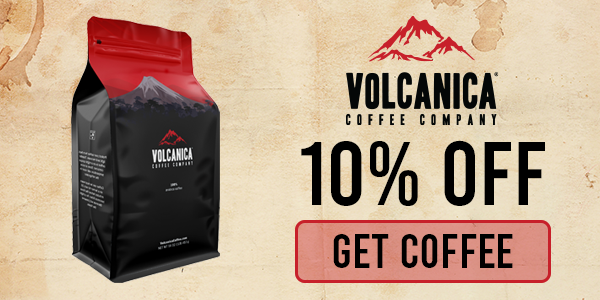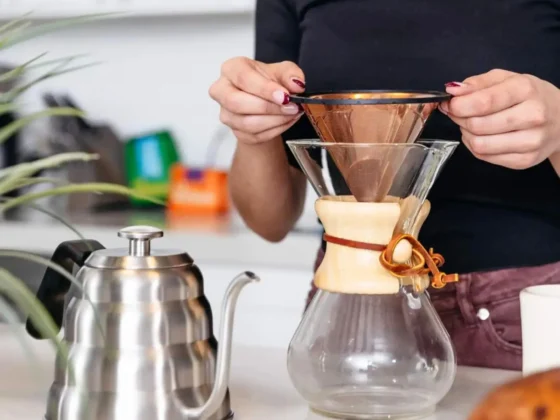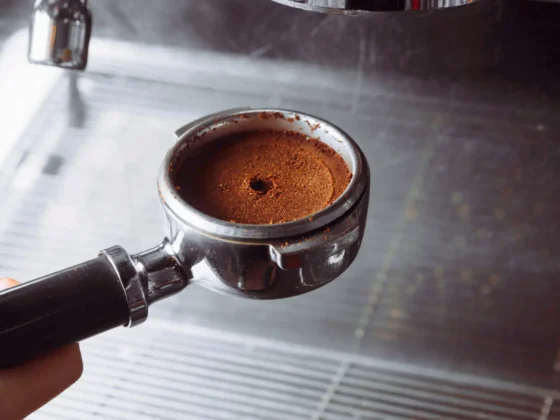Unraveling the mysteries of Kyoto-Style Cold Brew Coffee requires a deep dive into the remarkable device that makes it all possible – the Cold Brew Drip Tower. This unique method of brewing coffee, steeped in rich history and perfected through meticulous technique, creates a sensory experience unlike any other. This guide serves as your passport into the immersive world of this particular brew, offering insights into the origins, brewing techniques, and fine art of appreciating this exquisite coffee style. Whether you are a seasoned barista or a curious coffee enthusiast, this journey into the world of cold brew drip towers will enrich your coffee knowledge and, perhaps, transform your daily coffee ritual.
Cold Brew Drip Tower Guide: Key Takeaway
- Immerse in the Elegance of Kyoto: This delectable beverage, known for its unique slow-drip extraction process, offers a distinctive sensory experience that’s much more than just brewing a cup of coffee.
- Unveiling Flavors, One Drip at a Time: This meticulous brewing method, executed with a Cold Brew Drip Tower, results in a smoother, low-acidity brew, encapsulating the inherent flavors of the coffee beans.
- Mastering the Art of the Drip: Understanding the mechanics of the Cold Brew Drip Tower is crucial to fine-tuning your brew’s strength and flavor, taking your coffee experience to the next level.
- Brewing Excellence, Drip by Drip: The guide provides invaluable insights into the selection of coffee beans, ideal grind size, brewing ratios, and the intricacies of the extraction process for a superior beverage.
- Celebrating a Time-Honored Tradition: This guide goes beyond just the brewing process, delving into the cultural significance and global appreciation of this concoction, and encouraging coffee lovers to immerse themselves in this rich tradition.
The Guru’s Pick: Yama Glass Cold Brew Drip Tower
- BETTER TASTE: Ice water reservoir paired with slow drip system delivers 6-8 cups of premium cold brew ensuring you are extracting the full profile from you coffee grounds more effectively than traditional brewing methods
The Origins of Kyoto-Style Cold Brew Coffee
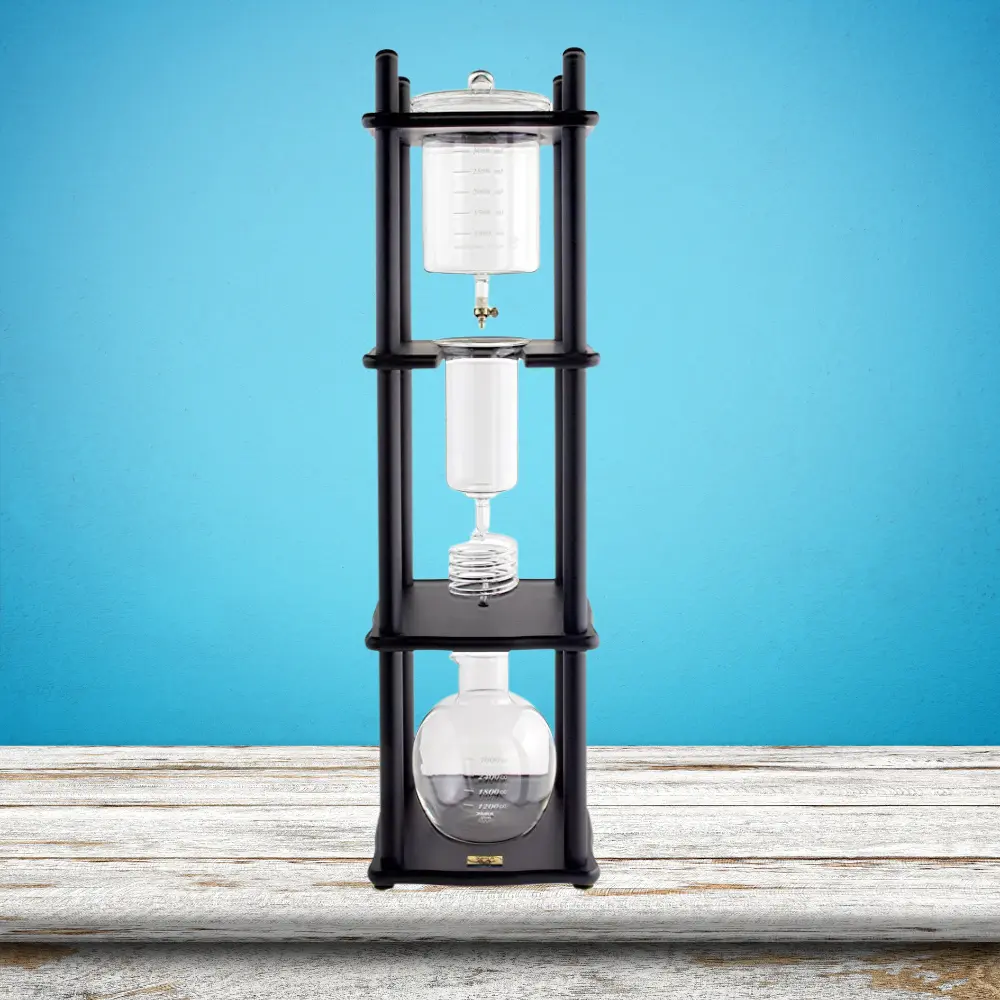
This distinctive brewing technique holds a unique place within the world of other coffee brewing methods. Its name, steeped in history and inspired by the city of Kyoto, Japan, suggests an ancient method. Yet, the art of this technique is relatively modern in its current form, intricately linked to the evolution of global coffee culture.
The Ancient Roots of Cold Brewing
The practice of this method can be traced back several centuries. To truly appreciate this type of brew, one must first understand the broader context of this brew itself.
In this method, coffee grounds are soaked in cold or room-temperature water for a long duration, typically ranging from 12 to 24 hours. This yields a concentrated brew that can be mixed with water or milk to produce a ready-to-drink coffee. This process emphasizes flavor profiles that are distinct from their hot-brewed counterparts, often presenting less bitterness and acidity.
Originating in Japan, cold brew coffee has a rich history as a time-honored brewing technique that has spanned centuries. The method, often referred to as Kyoto-style or Dutch coffee in East Asia due to the Dutch’s influence in introducing coffee essences to the region, involves a slow-drip process. During this process, water leisurely cascades through coffee grounds at ambient temperature, taking several hours to complete its flavorful journey.
However, it wasn’t until the 20th century that this method became more widely popularized in Japan and eventually gained recognition around the world.
Kyoto’s Influence on Coffee Culture
Moving from the general practice of this brewing technique to the specific case of Kyoto-style cold brew, Kyoto has had a considerable impact on how we view coffee today.

This Japanese city, renowned for its refined cultural practices, embraces a particular approach to coffee brewing that marries old-world techniques with modern-day sensibilities. Here, the drip process — where water is slowly dripped over coffee grounds — became a significant aspect of its coffee culture.
As opposed to the traditional immersion method, the drip process used in this brew tends to extract different flavor notes. This can result in a beverage that is simultaneously complex, smooth, and rich.
The name Kyoto-style came to be associated with this slow-drip method because of its popularity in the city’s coffee shops. Particularly distinctive is the use of the “cold brew drip tower,” an elegant contraption featuring a top chamber holding ice water, a middle chamber for coffee grounds, and a bottom chamber where the brewed coffee collects. This tower serves as a visual and cultural symbol of this brewing technique.
The Evolution of Kyoto-Style Cold Brew
This distinctive brewing method, once a local specialty, has now reached the status of a global trend.
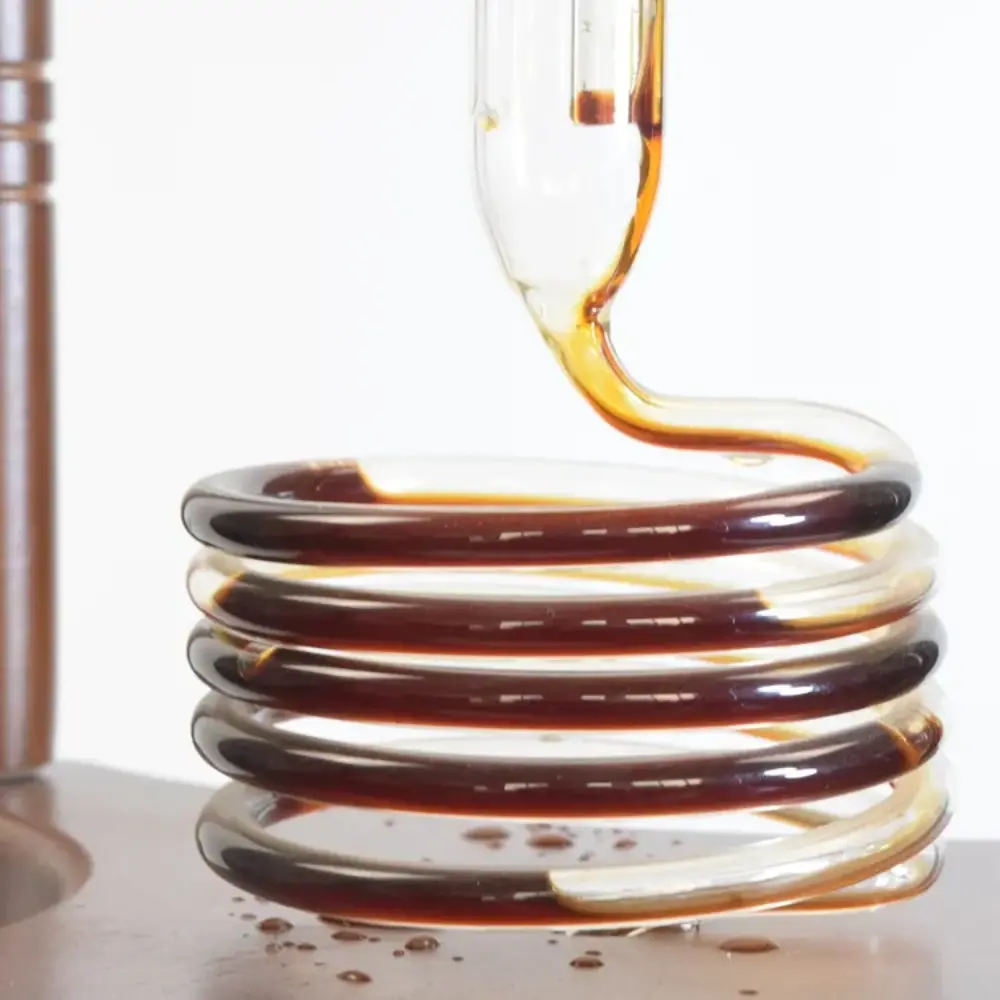
In the past couple of decades, the adoption and admiration of this brew have spread worldwide. Many coffee shops outside Japan, from the United States to Europe, now serve this type of brew, maintaining its traditional brewing method while adapting to local taste preferences.
This form of brewing has also given rise to innovation and experimentation in the coffee industry. Coffee professionals and enthusiasts alike continually experiment with the drip speed, water temperature, type of coffee beans, and grind size, all in pursuit of the perfect cup of this concoction.
Despite its international growth and evolution, this brewing technique stays true to its roots in its commitment to a patient, careful, and beautiful brewing process, capturing the essence of Kyoto’s enduring influence on the global coffee culture.
Understanding the Cold Brew Drip Tower
The Cold Brew Drip Tower, quintessential for brewing Kyoto-Style Cold Brew Coffee, strikes a harmonious balance between functionality and visual appeal. With its intricate design, the drip tower carries out the slow-drip brewing method to create coffee that has unique flavor profiles.
Exploring the Mechanics of the Drip Tower
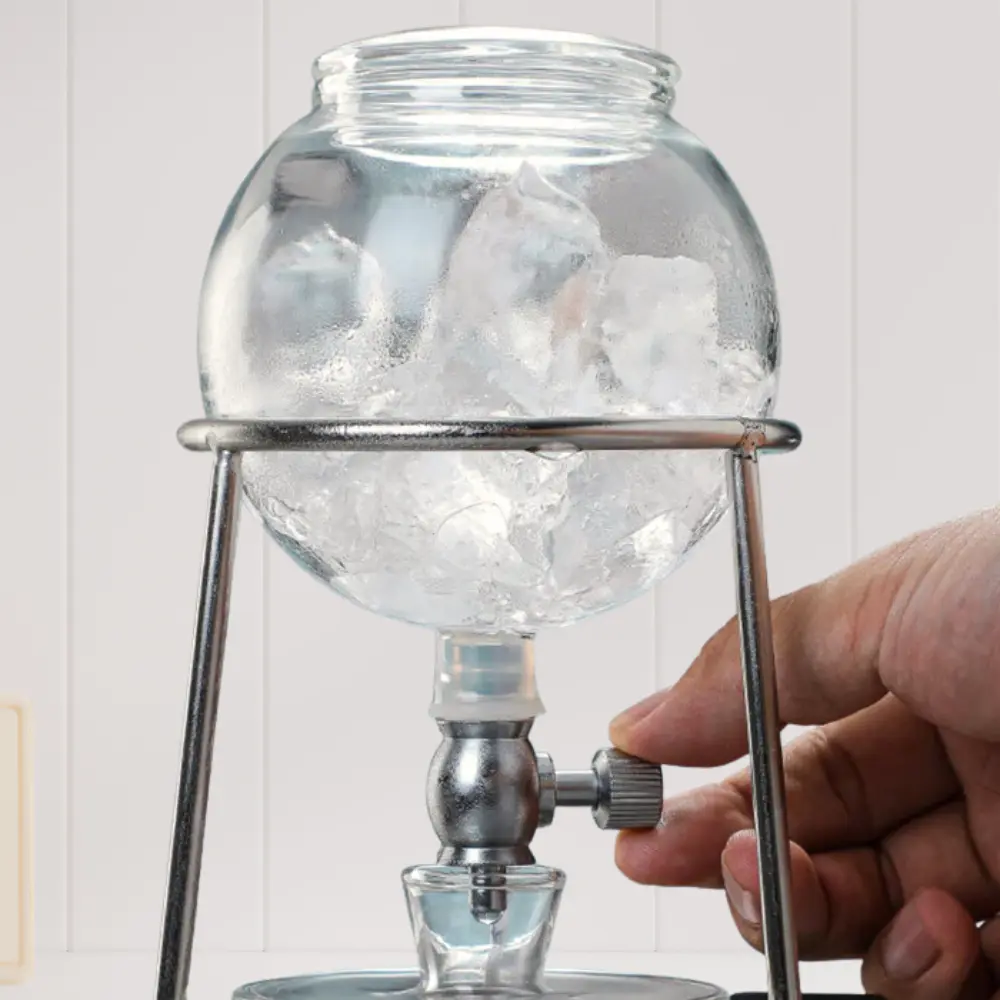
The mechanics of the Cold Brew Drip Tower revolve around a delightful blend of art and science. Utilizing basic physics principles, the tower extracts coffee through a process that is as methodical as it is aesthetically pleasing.
The process of the drip tower operates on three main principles:
- Gravity-Driven Process: The highest chamber of the tower is filled with cold water and ice. Over time, the water gradually drips onto a bed of coffee grounds in the middle chamber, following the principle of gravity.
- Slow Extraction: The water drips constantly through the coffee grounds, creating a slow extraction process that can last anywhere from several hours to an entire day. As the water seeps through the coffee grounds, it absorbs the flavors and oils, then slowly drips into the lowest chamber as the brew concentrates.
- Adjustable Drip Rate: A valve located between the water chamber and the coffee grounds chamber allows you to control the drip rate. This pace of extraction ensures that the water has ample time to interact with the coffee grounds, leading to a full-bodied and nuanced beverage.
Selecting the Right Cold Brew Drip Tower
Choosing the right Cold Brew Drip Tower involves a few considerations to enhance the quality of your beverage. These factors range from the materials used to the size and functionality of the tower.
Consider the following when selecting a drip tower:
- Material: The materials used in constructing the drip tower can affect both the flavor of the coffee and the durability of the equipment. Glass components are generally preferred, as they don’t impart any additional flavors to the brew.
- Size: The size of the tower is a significant consideration. Commercial establishments may need larger towers to meet customer demand, while at-home coffee enthusiasts may prefer smaller, more compact designs.
- Drip Rate Control: A reliable mechanism to control the drip rate is crucial. An inconsistent drip rate can lead to uneven extraction and an unbalanced final brew.
Essential Components of a Drip Tower Setup
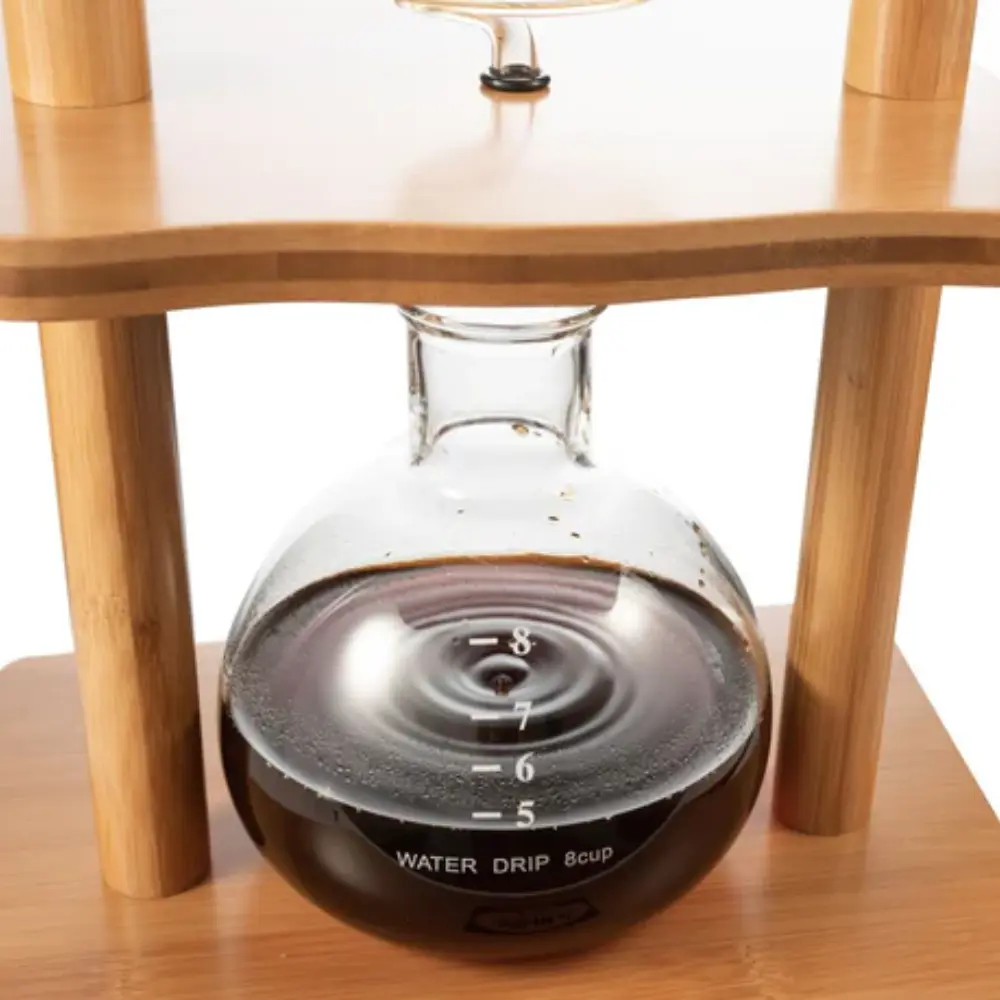
Regardless of the specific design of the brew dripper, three key components define a typical drip tower setup:
- Water Reservoir: Sitting at the top of the tower, this chamber is filled with cold water or a combination of water and ice, which gradually drips down through the setup.
- Coffee Chamber: Located in the middle of the tower, this section holds the coffee grounds. They are loaded and evenly distributed to allow for uniform extraction.
- Collection Chamber: Found at the bottom of the tower, this part collects the slow-drip brew concentrate. After brewing, the concentrate can be diluted with water or milk to create a flavorful and refreshing cup of joe.
Mastering the Kyoto-Style Cold Brew Technique
Mastering this brewing technique is about more than just having a cold brew drip tower. It also involves selecting the right coffee beans, adjusting grind size and brewing ratios, and understanding the steps for an ideal extraction process.
Coffee Beans: Choosing the Perfect Blend

The first step in preparing any quality coffee beverage lies in selecting the right coffee beans. This distinctive brewing technique is no exception.
- The choice of coffee beans plays a crucial role in the final taste profile of your brew. The slow extraction process of this brewing method tends to highlight the subtle nuances in the beans, bringing out unique flavor profiles that might be lost in other brewing methods.
- For this brew, consider using single-origin beans. These types of beans come from one specific location, and they often showcase unique flavors that can be interesting and delightful in this type of brew.
- Depending on your personal preferences, you might opt for beans with a light, medium, or dark roast. Light roasts tend to yield a more acidic and fruity flavor, while dark roasts can offer a bold, chocolatey, or nutty taste.
Grind Size and Brewing Ratios for Cold Brew
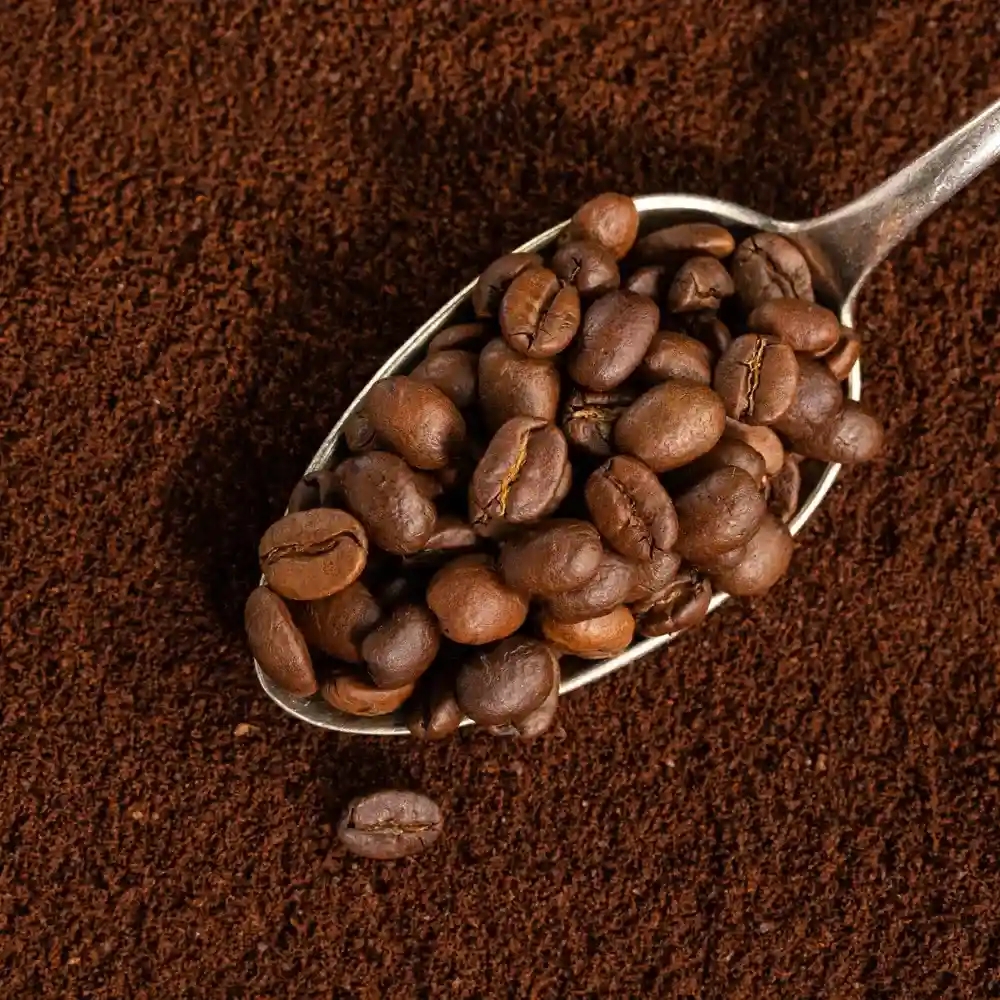
After selecting the coffee beans, understanding the grind size and brewing ratios are critical to producing a quality brew.
- The coffee grind size for this method should be medium-coarse to coarse. A grind that’s too fine can lead to over-extraction, resulting in a bitter taste. Conversely, a grind that’s too coarse might under-extract the beans, creating a weak and underwhelming brew.
- When it comes to brewing ratios, a common recommendation for this type of brew is a 1:8 coffee-to-water ratio, meaning for every 1 gram of coffee, you use 8 grams of water. However, this ratio can be adjusted depending on your personal taste preferences.
Step-by-Step Guide to Kyoto-Style Cold Brew Extraction

With the beans chosen and ground, and the brewing ratios figured out, you’re ready to start the extraction process in the cold brew drip tower.
Here is a step-by-step guide:
- Prepare the Drip Tower: Ensure that all components of the drip tower are clean and properly assembled.
- Add Coffee Grounds: Fill the coffee chamber with your desired amount of medium-coarse to coarse-ground coffee.
- Wet the Grounds: Before starting the brew, wet the coffee grounds with a small amount of cold water. This process, known as “blooming,” helps the coffee release any trapped gases, leading to better extraction.
- Add Water and Ice: Fill the top chamber with cold water and ice. The ice helps to maintain a consistent water temperature throughout the brewing process.
- Adjust Drip Rate: Set the drip rate to approximately one drip per second.
- Wait and Collect: The extraction process can take anywhere from 6 to 24 hours depending on your setup and taste preference. Be patient and allow the brew to collect in the bottom chamber.
- Serve and Enjoy: Once the brewing process is complete, you can serve your drink either straight or diluted with water or milk to your preference. Enjoy the complex, smooth, and rich flavor profiles that this brewing method has to offer.
Best Cold Drip Coffee Towers
The world of coffee is endlessly diverse, with every brewing method bringing its unique taste profile and experience. Cold drip coffee towers, specifically those used for making this type of brew, are no exception. They not only elevate the sensory pleasure of coffee but also double as functional art pieces. Let’s explore three exceptional cold brew drip towers that stand out in both form and function.
Nispira Wooden Cold Brew Drip Tower

- Vintage cold brew coffee maker set in wooden frame
The Nispira Cold Brew Drip Tower is a classic combination of style and substance. This coffee maker kit, encased in a tasteful wooden frame, offers a hands-on brewing experience that’s both engaging and rewarding.
- Key Features: It comes in two sizes – 600 milliliters and 2500 milliliters, suitable for small and large gatherings. The manual operation and adjustable valve make the drip operation customizable, allowing you to brew according to your taste.
- Performance: The Nispira Drip Tower promises a brew that’s sweeter, milder, and lower in acidity compared to typical iced coffee. However, patience is key here; the recommended brewing duration is 8 to 12 hours.
- Pros: Its elegant design doubles as a conversation piece, and the product is relatively easy to assemble and clean. The concise instructions included add to the user-friendly experience.
- Cons: The glassware quality reflects its affordable price and may not hold up well to frequent use. This product is best suited for occasional enthusiasts of this brew, rather than everyday users.
Yama Glass Cold Brew Drip Tower
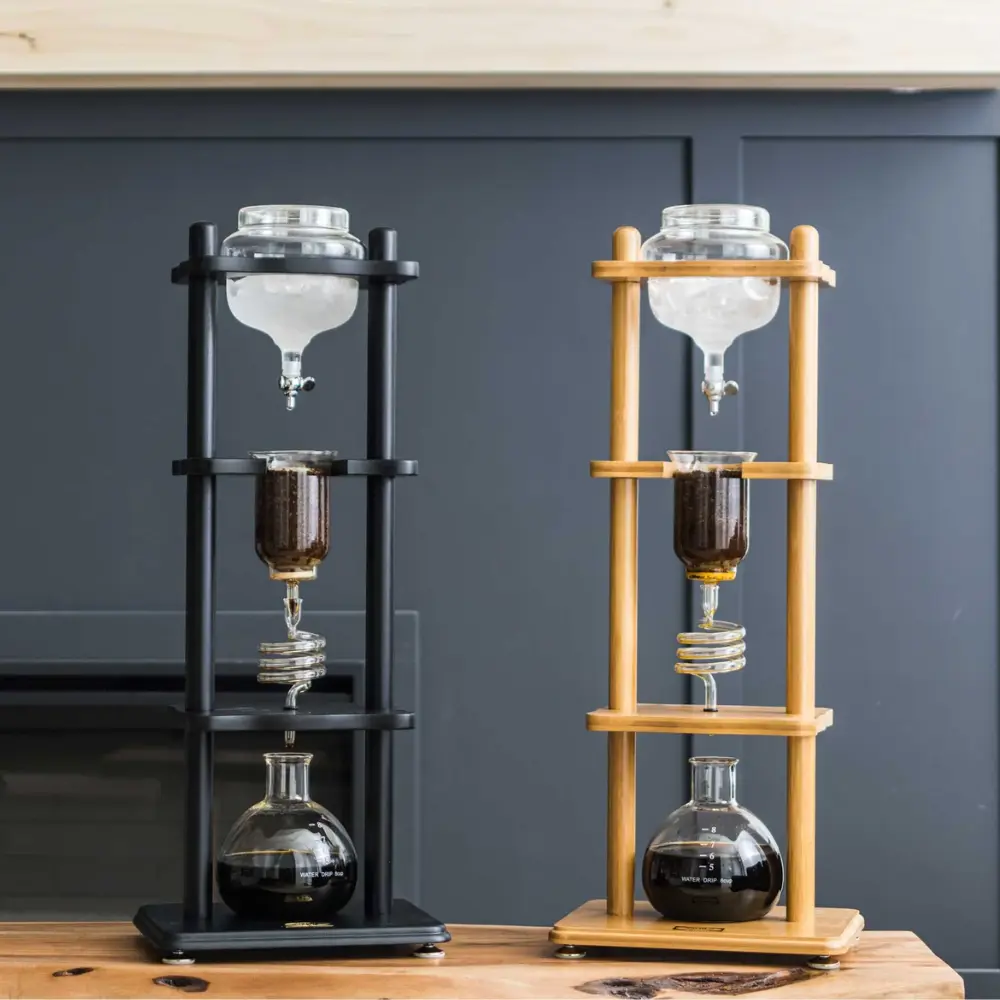
- BETTER TASTE: Ice water reservoir paired with slow drip system delivers 6-8 cups of premium cold brew ensuring you are extracting the full profile from you coffee grounds more effectively than traditional brewing methods
When it comes to precision and quality, the Yama Glass Cold Brew Drip Tower stands tall. This tower is known for its commitment to delivering flavorful and smooth coffee.
- Key Features: It has a 32 fl. oz. capacity, a perfect size for sharing. The hand-blown borosilicate glass construction is not just durable and odor-free but also lends a touch of elegance. Its manual operation and perennial filter make it a reliable choice for coffee aficionados.
- Performance: The Yama Tower employs a slow drip brewing method that extracts the full essence of coffee grounds. Its innovative design significantly reduces brewing time to 3-4 hours without compromising on quality.
- Pros: This tower offers enhanced flavor, quicker brewing time, and a combination of superior design and functionality. It’s also highly regarded for its durability, with a robust wooden tower and handcrafted glass components.
- Cons: The tower requires assembly, which could be challenging for some users. Also, its premium features come at a premium price, making it a more significant investment compared to other models.
NISPIRA Stainless Steel/Borosilicate Glass Cold Brew Dripper Coffee Maker
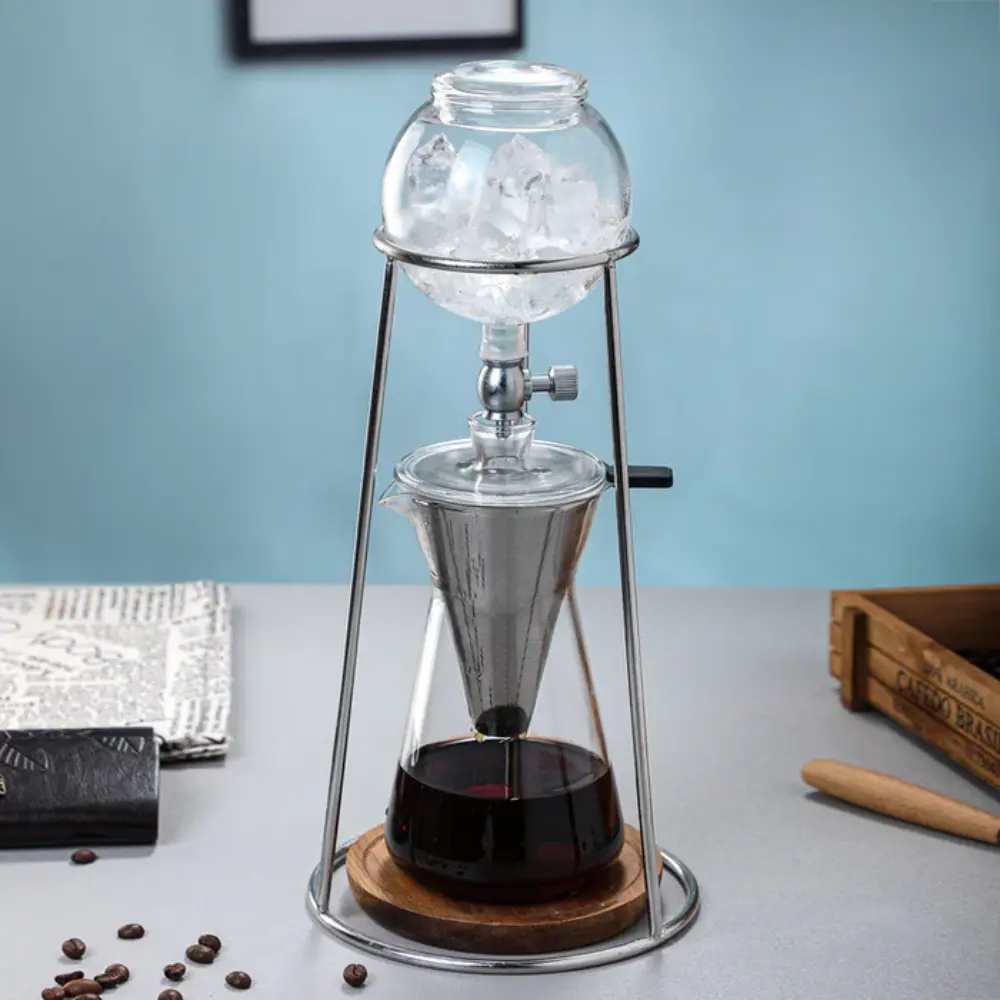
- An elegant design cold brew coffee set perfect for home and kitchen.
- An elegant design cold brew coffee set perfect for home and kitchen.
The NISPIRA Stainless Steel/Borosilicate Glass Cold Brew Dripper strikes a balance between modern design and traditional brewing techniques. This coffee set is perfect for both household and culinary use.
- Key Features: Available in three sizes (400 ml, 600 ml, and 1000 ml), it caters to different user needs. The striking silver stainless steel or copper stand combined with heat-resistant glass provides a visually appealing contrast.
- Performance: This dripper brews a delightful beverage, well-suited for 6 to 8 individuals depending on the model. Its quality is said to be on par with, if not surpassing, leading brands.
- Pros: It brings together functionality and contemporary aesthetics. Its varied size options make it flexible for different user needs, and it guarantees complete customer satisfaction.
- Cons: While it promises high-quality performance, the product does not mention any unique features or proprietary technology that sets it apart from other cold brew drip towers.
Elevating Your Cold Brew Experience
While the cold brew drip tower is at the heart of this brewing method, the whole experience is about more than just the brewing process. From exploring classic and creative recipes to the artistry of presentation and the use of additional accessories, there’s much more to enhancing and enjoying your coffee experience.
Cold Brew Recipes: Classic and Creative Variations

There’s a world of creativity waiting to be explored beyond the basic cold brew recipe. Experimenting with different elements can bring an exciting twist to your classic brew.
- Classic Cold Brew: This classic concoction is served black, either neat or over ice. This method truly allows the unique flavors extracted by the brew dripper to shine.
- Sweetened Cold Brew: While traditionalists might prefer their brew without any additives, adding a bit of sugar or simple syrup can bring a new dimension to your drink. For those who prefer a creamier texture, adding milk or cream can create a delightful latte.
- Flavored Cold Brew: To get even more creative, consider incorporating different flavors into your brew. This could be as simple as adding a few drops of vanilla extract, a sprinkle of cinnamon, or even mixing in some cocoa powder for a mocha-style cold brew.
- Cold Brew Cocktails: For a sophisticated twist, this type of brew can be used as a base for various cocktails. Combine your brew with a shot of whiskey, some simple syrup, and a dash of bitters for a coffee-inspired take on an Old Fashioned.
Serving and Presentation: Unveiling the Artistry
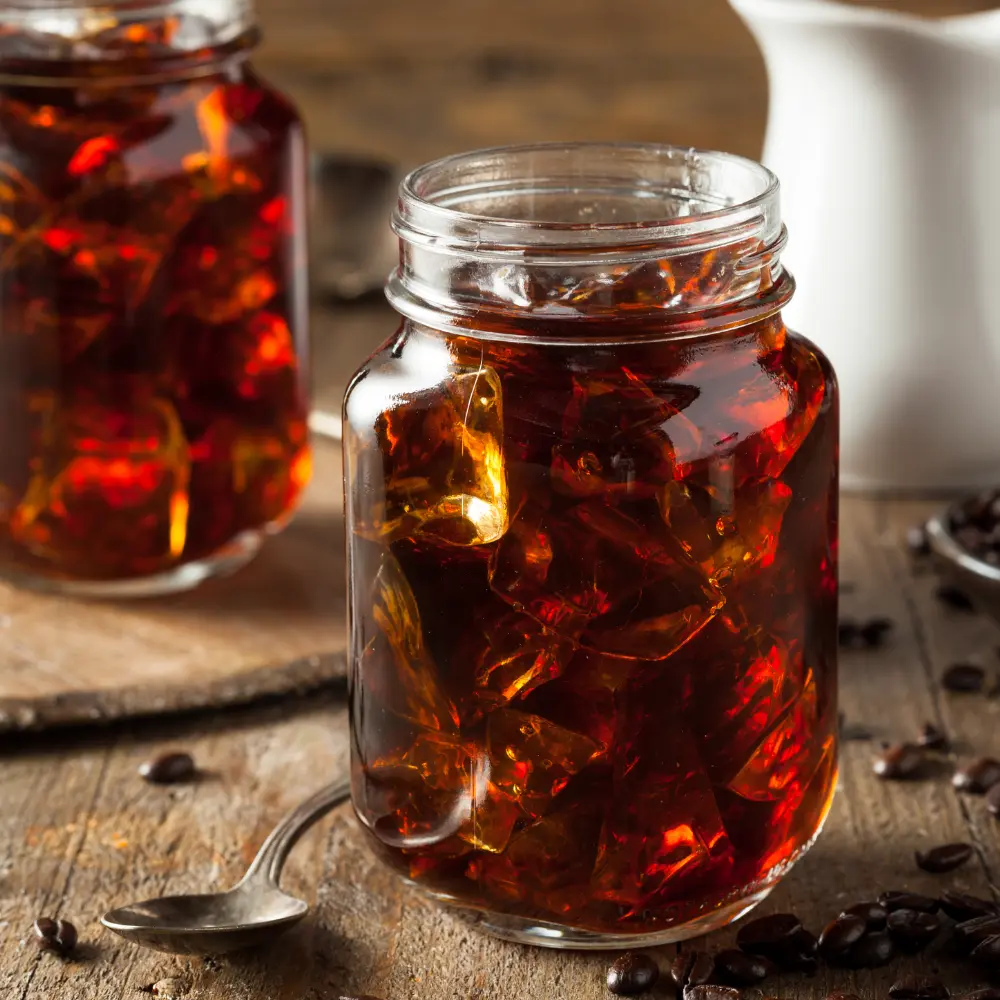
The artistry of this type of brew extends beyond brewing and into serving and presentation. How you present your drink can add to the overall experience and enjoyment.
- Glassware: The right glass can enhance your experience. Clear glasses are particularly popular because they allow the beauty of the coffee to shine through. Choose a glass that is the right size for your beverage and complements the overall aesthetic of your presentation.
- Temperature: This type of drink is usually served chilled. Use ice cubes to keep your beverage cool without diluting it excessively. For an extra touch, consider making coffee ice cubes to ensure that the flavor isn’t diluted as the ice melts.
- Garnish: While not necessary, adding a garnish can bring an extra level of sophistication to your brew. This could be anything from a slice of orange for a citrusy cold brew cocktail to a sprig of mint or a cinnamon stick for a sweetened or flavored brew.
Cold Brew Accessories: Enhancing Your Brewing Ritual
In addition to the cold brew drip tower, other accessories can help refine your brew ritual and elevate the overall experience.
- Coffee Grinder: Having a quality coffee grinder at home will allow you to adjust your grind size to the perfect consistency for your brew.
- Scale: A scale can be incredibly helpful for measuring your coffee and water, ensuring accurate brewing ratios for the perfect extraction.
- Thermometer: While not essential, a thermometer can assist in keeping your water temperature consistent, especially if you’re not using ice.
- Storage Container: Once brewed, your brew concentrate should be stored in a sealable glass container in the refrigerator. This keeps it fresh and ready to serve for up to two weeks.
From brewing to serving and enjoying, mastering the art of this brewing technique involves a journey of experimentation and refinement. Take your time and savor each moment to fully appreciate the art and flavor of this unique brewing method.
Exploring the World of Kyoto-Style Cold Brew Coffee
Venturing into the world of this brewing technique takes you beyond your everyday coffee experience. From savoring unique flavors at renowned coffee shops to witnessing global innovations in this type of brewing and replicating the technique at home with a cold brew dripper, there’s a lot to explore and appreciate.
Noteworthy Kyoto-Style Cold Brew Coffee Shops
The birthplace of this unique brewing method, Kyoto, Japan, naturally houses several noteworthy coffee shops where you can taste authentic Kyoto-Style Cold Brew. But the reach of this technique extends globally, with many cafes around the world embracing this brewing style.
- Cafes in Kyoto: In Kyoto, the city that inspired this brewing method, you can visit cafes such as Vermillion and Cafe de l’Ambre. These establishments not only serve traditional Kyoto-Style Cold Brew but also provide a deep dive into Japanese coffee culture.
- International Presence: Outside of Japan, the slow-drip cold brewing method has gained popularity in various global coffee hubs. For instance, Blue Bottle Coffee in San Francisco and Single Origin Roasters in Sydney have embraced this type of brew, capturing the intricate beauty of the brewing process and its flavor-packed results.
Cold Brew Innovations: Global Influence
While this brewing technique remains deeply rooted in its traditional methods, it’s also been a source of inspiration for innovative ideas in the global coffee scene.
- Design Innovations: Designers and coffee enthusiasts alike have reimagined the classic design of the drip tower, incorporating modern aesthetics and functionality. These innovations have led to the creation of compact and portable drip towers suitable for home use, without compromising on the quality of the brew.
- Variations in Brewing Methods: Some cafes and coffee enthusiasts have introduced variations to the traditional Kyoto-Style Cold Brew process. For instance, some experiment with different coffee brewing temperatures, grind sizes, or drip rates to yield new flavor profiles.
- Integration with Technology: With the rise of smart home devices, there’s been a trend toward integrating technology with this brewing process. This includes automated cold brew machines that can mimic the slow drip process while providing control over variables such as temperature and drip rate via smartphone apps.
Embracing Kyoto-Style Cold Brew at Home
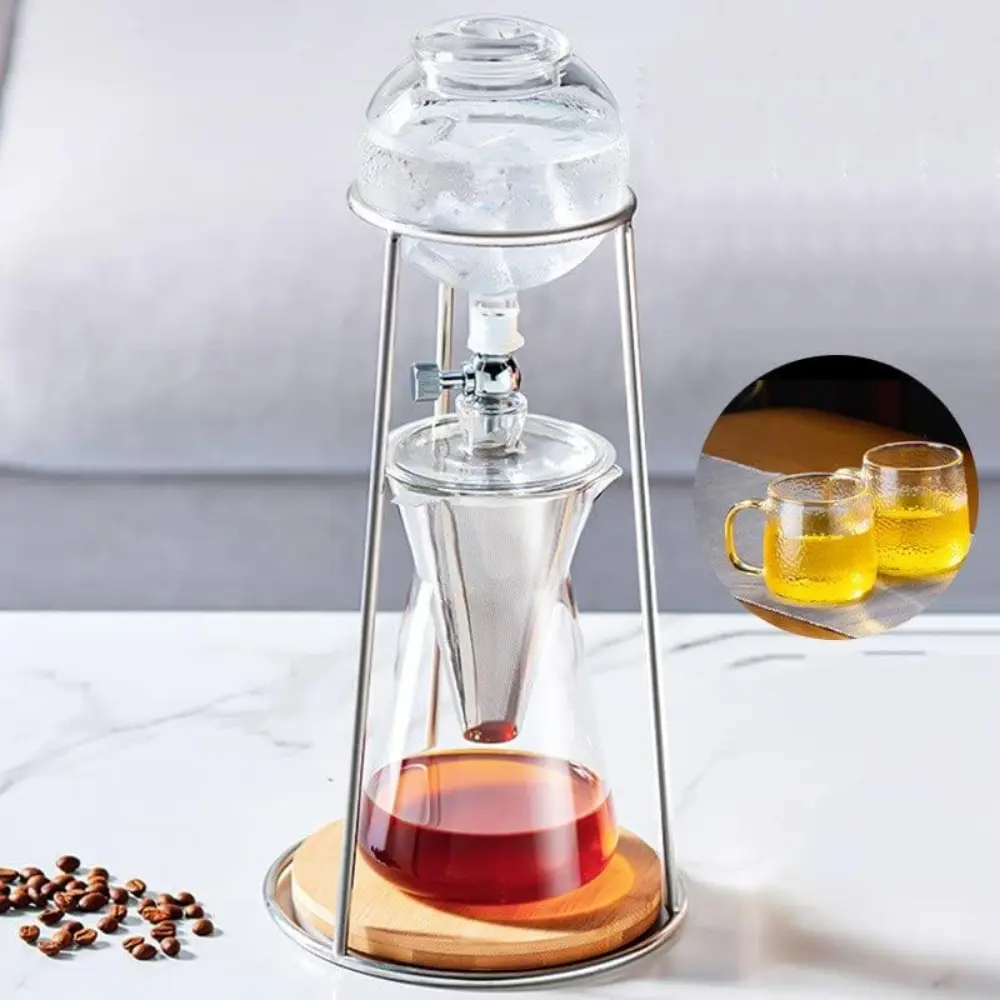
With the availability of compact and user-friendly cold brew drippers, embracing this brewing method at home has never been easier.
- Accessible Equipment: Nowadays, equipment manufacturers offer a range of drip towers suitable for home use. They’re designed to fit into home kitchens both in terms of size and aesthetics while still offering the slow-drip brewing experience.
- Quality Home-Brewed Coffee: The rise of at-home cold brewing allows coffee enthusiasts to brew quality coffee that rivals the offerings of specialty cafes. With the right equipment, high-quality coffee beans, and a bit of patience, you can master the art of this type of brew in the comfort of your own home.
- Experimentation and Personalization: Home brewing also provides the opportunity to experiment and personalize your brew. You can play with different coffee beans, tweak the grind size, adjust the brewing ratio, or incorporate flavors to create a brew that suits your unique taste preference.
With its deep roots in tradition, innovative influence, and growing accessibility, the world of this brewing technique offers a rich and rewarding journey for coffee enthusiasts. Whether you’re a casual drinker or a dedicated coffee connoisseur, there’s much to learn, taste, and enjoy in this brewing method.
Conclusion
As we reach the end of our Cold Brew Drip Tower Guide, it’s clear that the allure of Kyoto-Style Cold Brew Coffee extends far beyond its striking visual appeal. Its meticulous preparation process, unique flavor profiles, and rich cultural history make it a fascinating exploration for coffee lovers worldwide.
Understanding the complexity and artistry of the Cold Brew Drip Tower is key to truly appreciating the result—a brew that’s as smooth as it is flavorful, capturing the very essence of the coffee bean itself. As we continue our personal coffee journeys, it’s worth remembering the magic of this ancient brewing technique, a testament to coffee’s enduring charm and transformative potential.
Whether you’ve been inspired to try brewing at home or have developed a newfound appreciation for your local barista’s skill, we hope this guide has enriched your understanding of this distinctive brewing technique. Now armed with this knowledge, each sip from your future brews will surely carry a deeper resonance, paying homage to a tradition that has stood the test of time.
FAQ
What are the key differences between Kyoto-style cold brew and other cold brew methods?
This type of brew is characterized by a slow drip method rather than steeping the coffee grounds, which is common in other brewing methods.
Are there any specific coffee bean origins recommended for Kyoto-style cold brew?
There's no specific recommendation; this brew works well with any high-quality coffee bean, though the flavor profile will vary with different origins.
Can I use a different brewing device instead of a drip tower for Kyoto-style cold brew?
A drip tower is essential for this type of brew due to its unique slow drip extraction method, which can't be replicated with other devices.
How can I adjust the strength and flavor profile of my Kyoto-style cold brew?
You can adjust the strength and flavor of your brew by altering the coffee-to-water ratio, grind size, and drip speed.



